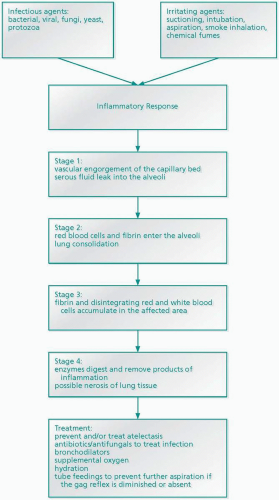Pneumonia: Acquired Disorders Involving Alveoli
QUICK LOOK AT THE CHAPTER AHEAD
Childhood mortality from pneumonia has declined dramatically. Pneumonia, which is more common before age 5 than in later childhood, is an inflammatory process that may be caused by numerous infectious agents such as bacteria, viruses, fungi, yeast, or protozoa (Figure 50-1). Streptococcus pneumoniae is responsible for up to 75% of all cases of pneumonia. In contrast to bacterial pneumonia, viral pneumonia is usually mild and heals without intervention; however, it can lead to a more virulent bacterial pneumonia.
 Figure 50-1. Pneumonia. |
Irritating agents or events such as suctioning, intubation, aspirated gastric juice, inhalation of smoke, or chemical fumes can also lead to pneumonia. Aspiration pneumonia may occur because the gag reflex is impaired, as in children with seizures or with anatomic abnormalities such as cleft palate, or because a nasogastric tube prevents the lower esophageal sphincter from closing, allowing gastric juice or tube feeding to enter the lungs. Gastric secretions and tube-feeding formulas are irritating to lung tissue and set up an inflammatory response when aspirated.
Other common causes of pneumonia are stasis of respiratory secretions and thickened secretions. Stasis of secretions in a child with cystic fibrosis can lead to pneumonia because bacteria can grow in the static secretions. When respiratory secretions become thick ciliary action cannot remove the bacteria-laden mucus, and pneumonia may result.
Pneumonia may be classified by the agent that causes it or by its location in the lung. Lobar pneumonia is confined to a single lobe of the lung, whereas bronchopneumonia, the most common type, is described as patchy pneumonia in several lobes. Atypical pneumonia, usually caused by viruses (type A/B influenza) or some bacteria (Legionella), is also patchy but does not involve the alveoli. Pneumonia may also be classified according to where it was acquired. Nosocomial pneumonia is pneumonia acquired while the child was hospitalized, and community-acquired pneumonia is pneumonia acquired outside of a hospital/health care setting.
Stay updated, free articles. Join our Telegram channel

Full access? Get Clinical Tree


